ENGAGE
Well-thought-out communication and engagement plans result in more effective, successful, and supported adaptation. Climate adaptation often requires field building and change management.
As such, engaging internal and external stakeholders (two-way communication, listening and sharing) to motivate action, connect with and support others, and develop climate messages can go a long way toward making your adaptation efforts successful.
The following leading practices are in the action area of ENGAGE and are described below:
- Recognize many ways to motivate climate adaptation action
- Seek out and support climate champions throughout your utility (also in SUSTAIN)
- Consult expertise throughout your utility regularly and with purpose
- Tailor the climate adaptation message for the intended audience
- Develop a climate communications plan
- Include equity from the beginning
- Make the business case for climate adaptation (also in SUSTAIN)
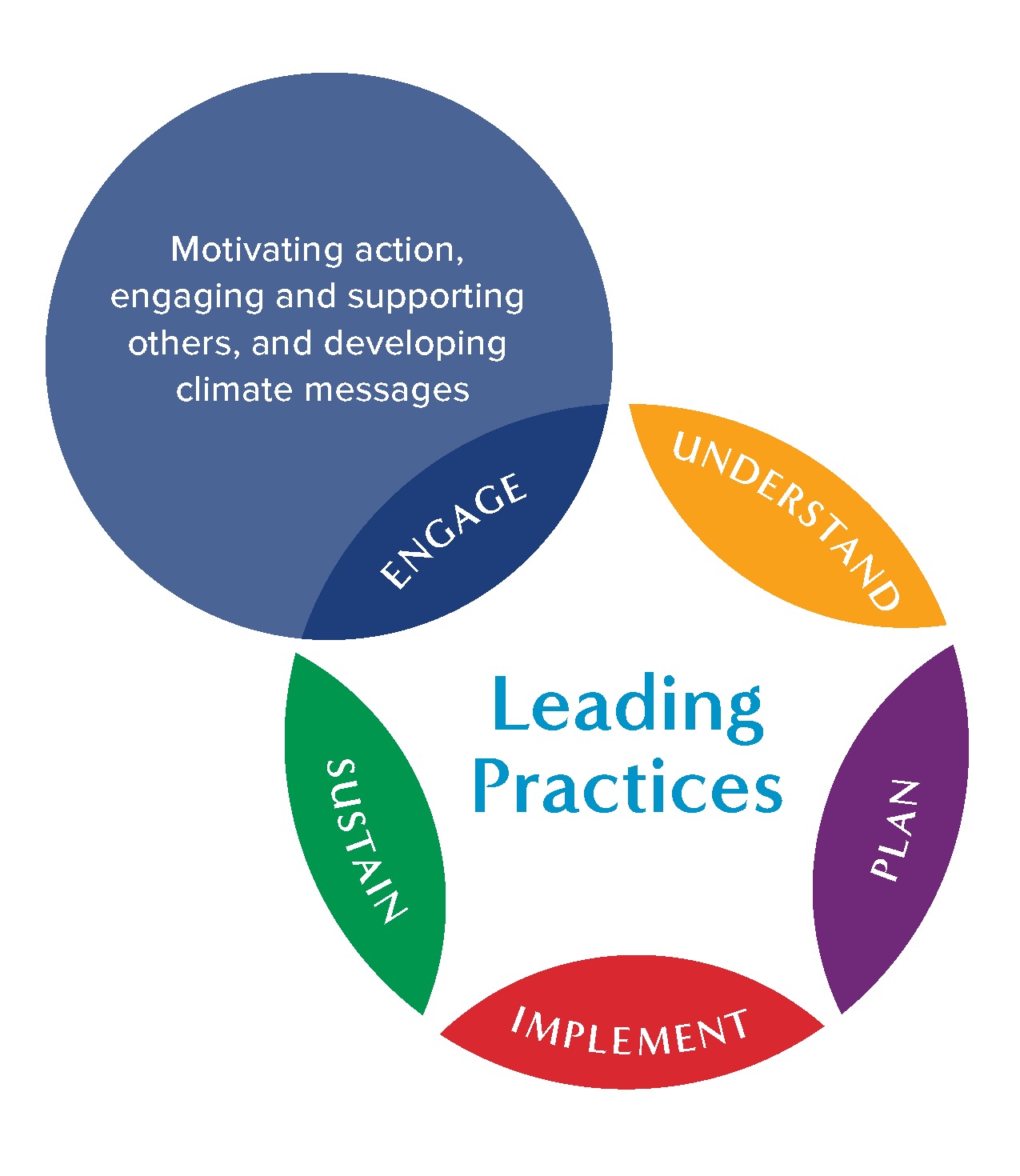


Recognize many ways to motivate climate adaptation action
Many things can motivate investment in climate adaptation, including climate champions, natural disasters or crises, peer and public pressure, personnel changes, personal observations of change, and access to new knowledge. Leverage the motivational opportunities that fit your circumstances.
Example: Simultaneous natural disasters in Colorado
In 2002, Denver Water saw unprecedented simultaneous natural disasters in its watersheds. During the single worst one-year drought ever recorded in Colorado, the largest wildfire the state had ever seen occurred in one of its largest and hardest working watersheds. Just weeks after the fire was contained, a rainstorm brought sedimentation and debris into streams and reservoirs, significantly impacting water quality and reservoir capacity.
Now, nearly two decades later, the watershed is still noticeably scarred, and the memory of the 2002 natural disasters is still very present. While climate change did not cause these disasters, science tells us that recent warming contributed to their impacts.
Overall, the experience helped Denver Water understand the importance of addressing climate change challenges. Now, dedicated staff actively work to understand and prepare for changes that may dramatically impact Denver Water's system and business model, such as continued warming and extreme heat; intensified droughts, floods, and forest fires; and changes to snowpack, Denver Water's high-elevation supply source.
Example: Droughts and floods in Texas
Austin, Texas, is prone to frequent droughts often followed by intense rainy periods. The most recent drought (2008-2016) dropped water levels in area reservoirs to near-record lows and ultimately surpassed the severity of the 1950s' drought of record. In some areas, lake levels were so low that it became difficult to launch boats and enjoy other water-based activities. The drought and high temperatures also took a visible toll on landscapes and other vegetation.
Then, in 2018, historic flooding brought massive amounts of silt and dirt—over 100 times the typical level—into Austin's drinking water supply. This impacted raw water quality and slowed treatment systems. To ensure adequate flows in case of fires, Austin Water issued the first system-wide boil water notice in its 100-year history. With climate change, the utility expects these types of events to become more frequent and severe.
Austin's leadership has long acknowledged and addressed climate impacts in its water planning efforts. The public has benefited, especially in the context of recent events, building momentum for additional actions. Most recently, the Austin City Council adopted Water Forward, an integrated water resource plan, which used a regional water supply context to develop strategies to ensure a sustainable and resilient water future into the next century.
This experience can also help the abstract concept of climate change become more concrete (see ENGAGE: Tailor the climate adaptation message for the intended audience).
Example: Collective action because of a summit
In January 2007, the San Francisco Public Utilities Commission (SF PUC) hosted the first national Water Utility Climate Change Summit, which was attended by more than 200 water and wastewater utility executives, government officials, climate change experts and environmental leaders. The purpose of the gathering was to help participants better understand the impacts of climate change on water-related infrastructure and water resource supplies.
During that summit, utility leaders recognized the future risks and value a collective effort would bring to the climate adaptation conversation. As the summit drew to a close, SF PUC General Manager Susan Leal committed to fund an effort from the dais and issued a challenge to attendees. Turning to Metropolitan Water District of Southern California General Manager Jeff Kightlinger, who had served on a panel but was now back in his seat among the audience of 200, she said: "Jeff?" Kightlinger replied, "Sounds good to me!" and turned to his Board Chair, Tim Brick, who was also in the audience, and said "Tim?" Brick gave his thumbs up, Metropolitan matched the San Francisco Public Utilities Commission's pledge, and planning for what became WUCA began.
(Interesting note: that initial pledge lasted nearly ten years because the bulk of WUCA's work has been driven by utility staff and volunteer experts drawn into the collaboration). Shortly after the summit, WUCA was formed, which has led to over a decade of innovative work in climate adaptation, as highlighted throughout these leading practices.


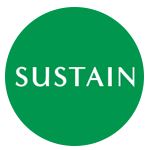
Seek out and support climate champions throughout your utility
Progress happens more quickly with the support of motivated individuals who value and prioritize climate adaptation work, including executive-level leaders. It is therefore important to build relationships with and educate champions who can influence climate adaptation actions, then help sustain and strengthen those efforts. Having champions across an organization (in planning, engineering, finance, public relations, and other roles) can contribute diverse expertise and resources and help provide institutional memory as individuals' roles change.
This practice is included under both ENGAGE and SUSTAIN climate adaptation actions.
Example: Building a cross-functional team of champions
The Central Arizona Project (CAP) climate adaptation plan was developed with an education and engagement mindset, which elevated existing and promoted future climate champions throughout the organization. Key to the development of the plan was the active participation of a cross-functional team of internal experts comprising all of CAP's climate-sensitive functions, including water policy, operations and engineering, maintenance, public affairs, technology, legal services, finance and administration, and employee services.
The team collaboratively identified implications of climate change for CAP's functions as well as all components of the CAP climate adaptation plan. This approach helped foster climate champions in each of CAP's organizational functions by actively educating and engaging them in the climate adaptation process. It also gave members of the CAP team ownership in addressing CAP's climate challenges.
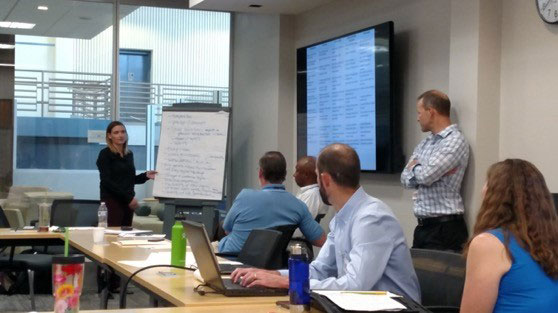
SOURCE: CAP
Example: Interactive climate education with an organization
One important way to build climate champions is through interactive climate education sessions within an organization. For example, Denver Water includes a "Climate 101" unit in all orientation sessions for new employees and provides climate science, adaptation, and mitigation information in its new employee onboarding package. As part of the Climate 101 education sessions, new employees are given prompts to brainstorm how climate change could impact various utility business functions (finance, water treatment, construction, etc.). This approach gets employees thinking creatively about climate change from day one of the job and establishes a baseline level of climate knowledge.
After a Climate 101 session, a new employee of Denver Water's youth education team was inspired to integrate climate change into the youth education curriculum and has since created an entire climate change and water module that is presented to schools throughout the region. Building on the successful implementation of these Climate 101 sessions for new employees, the climate team began offering the sessions to other sections at the utility, usually in groups of three to five people to allow for more interactive conversation.
This small scale and interactive approach to climate education has allowed the climate team to build climate champions throughout the organization, as well as to build relationships and co-produce climate adaptation ideas with subject matter experts from many business functions.
Example: A dedicated person to support champions utility-wide
Austin Water has a long history of implementing a variety of climate planning and management measures. While these efforts have traditionally been housed in the Environmental Affairs and Conservation Program Area, climate work has also been done across utility program areas—like Operations, Pipeline Engineering, and Water Resources Management—and, to some extent, in different city departments.
In 2019, Austin Water established a new staff position, Climate Protection Consultant, to place additional utility-wide focus on climate issues. This includes taking steps to enhance information sharing about climate change across the utility, continuing to better incorporate climate concerns into cross-functional utility planning efforts, and representing Austin Water on city-wide climate planning initiatives. This position reports to the Assistant Director of Environmental, Planning, and Development Services. This reporting structure provides frequent opportunities for sharing climate-related information with utility leadership.
In addition, the Office of Sustainability, a department within the City of Austin, is currently evaluating options for creating a new Chief Climate Resilience Officer position to address city-wide climate resilience planning and strategy implementation.
See job postings examples:
Many WUCA member utilities have dedicated people within their organizations (e.g., this report's authors) to promote champions (see SUSTAIN: Establish a community of practice to integrate climate change utility-wide for related examples).
Example: Identifying champions within an organization
Philadelphia Water Department identified champions throughout the organization as part of an internal communications strategy (see ENGAGE: Develop a climate communications plan).
Example: Building community for champions
Fostering a community of practice can help build and support champions (see SUSTAIN: Establish a community of practice to integrate climate change utility-wide for examples of how to build community).


Consult expertise throughout your utility regularly and with purpose
Adapting to climate change requires diverse expertise and broad participation, both of which can be gained by consulting others throughout your organization. The type of engagement that works best varies depending on an organization's culture, but a little forethought and some regularity can go a long way (e.g., begin with listening and ask what matters).
Example: Business function conversations
Southern Nevada Water Authority (SNWA) climate adaptation staff initiated a process of engagement with internal experts by first sharing results from a region-specific climate change projection study. At early meetings, department heads learned about the types of changes expected in the future and weighed in on how these changes might impact utility business functions.
From these initial meetings, a few key business function areas were identified to develop adaptation actions. Then, SNWA set up small group meetings and interviewed each business function area to gather how the organization's experts thought they could address potential impacts. Conversations were summarized, and each small group reviewed the recommended actions and helped develop next steps.
The process accomplished several goals:
- It educated staff about climate change
- It introduced staff to SNWA's climate leadership so they know whom to contact in the organization with questions
- Because business function experts were the ones to develop the solutions, it ensures buy-in and increases the likelihood that proposed solutions will be implemented
See Example: Business function mapping to learn about a framework for considering climate change across an organization’s business functions.
Example: Trash removal as an unexpected adaptation need
Adaptation planners at the Philadelphia Water Department (PWD) recognized that successful adaptation requires expertise on both climate science and operations. It is not possible for PWD's adaptation planners to possess all of the necessary operational knowledge for the numerous systems PWD operates and maintains across the city (drinking water, wastewater, and stormwater).
So the PWD Climate Change Adaptation Program (CCAP) prioritized engaging in two-way conversations with utility operators early and often to share information and begin developing meaningful solutions/adaptation strategies. For example, PWD's adaptation planners met with operations staff at one of PWD's wastewater treatment plants. After presenting future projections of precipitation increases, the operators shared that these conditions would likely produce more trash, accumulating at faster rates, during the initial screening stage of the wastewater treatment process.
This consequence, which was only identified after consulting with plant operators, has implications for resources—more staff and equipment may be needed to remove and process trash to maintain current levels of service.
Example: Utility-wide climate adaptation planning
Preparing a Climate Adaptation Plan provides an opportunity to form a cross-functional team with a clear purpose (see ENGAGE: Seek out and support climate champions throughout your utility).
Important lessons
- Have well-organized information for people to react to.
- However, do not wait for the analysis to be perfect—share what you have along the way.
- Strike the right balance between reaching out to staff and respecting their time.


Tailor the climate adaptation message for the intended audience
One key to successful communication is knowing your audience(s) and framing your message so it has meaning and value to them. A climate adaptation message that resonates with one individual or group might not "land" with others. Identifying which messages work best is time well spent.
Example: Be clear why climate change matters
Over the past 10 years, the Alliance has homed in on messages that resonate with water utilities to demonstrate the impact climate change could have on critical utility operations and functions. Powerful, clear messages that connect climate change to water utility responsibilities include climate change is water change and warming is here and now. For more, key messages from WUCA are posted on our home page.
Given competing priorities, climate adaptation needs to be communicated internally in a way that resonates with critical organizational functions.
Example: Messages that resonate with engineers
When the Philadelphia Water Department (PWD) Climate Change Adaptation Program (CCAP) was ready to share information and results from analyses internally, success—i.e., whether climate information would eventually be adopted within existing planning, design, and asset management processes—hinged on good communication.
For example, when sharing information with engineers who work on long-term infrastructure plans, CCAP first explained how climate change is altering the water cycle and how climate non-stationarity might challenge standard engineering practices, procedures, and tools. Planners and design engineers are used to working with return intervals and other statistical tools and methods that are based on historic data.
It was essential to explain that, because of climate change, these traditional tools and methods may no longer be adequate moving forward. It was also important to convey that the CCAP team is available to help PWD staff tackle these challenges.
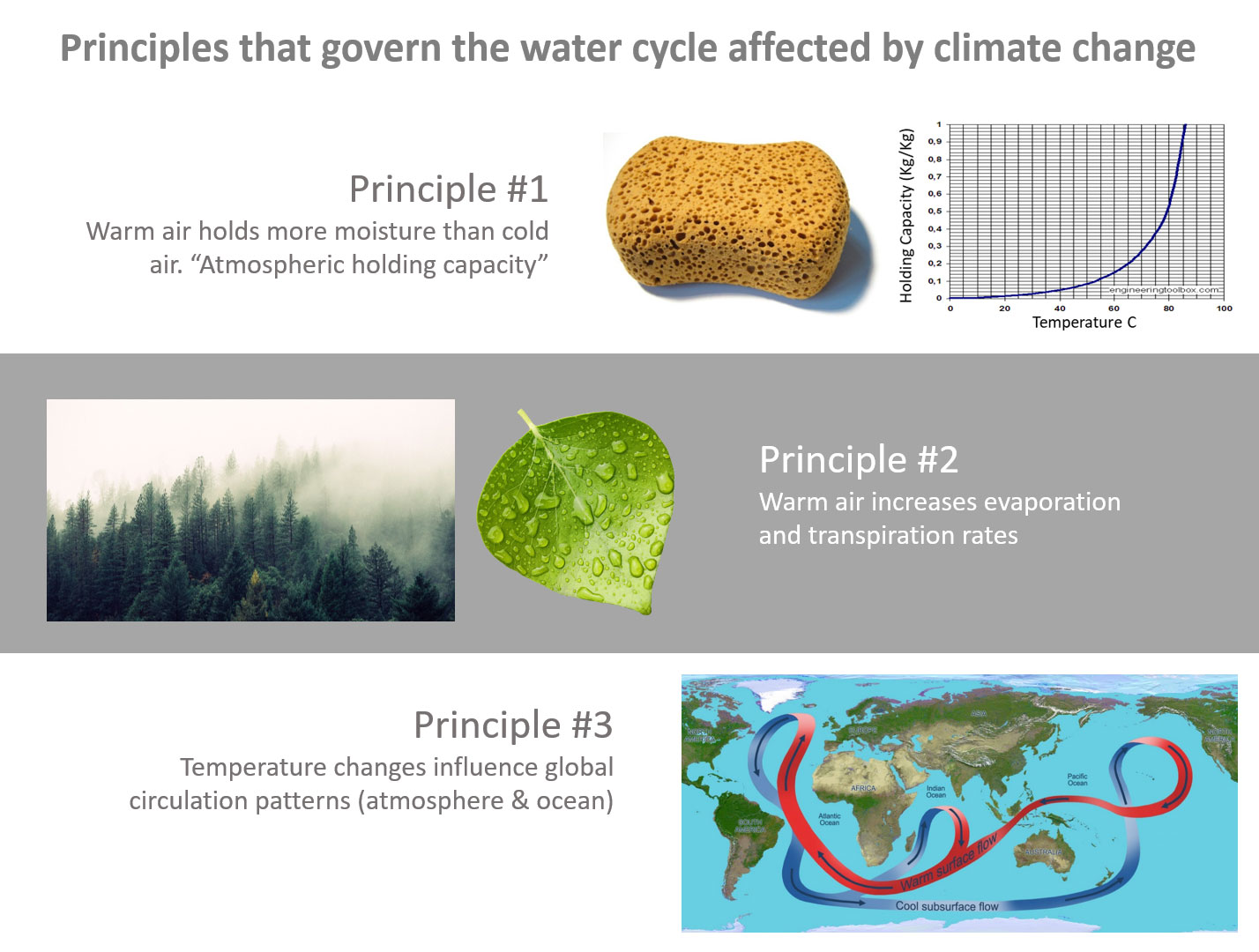
Example: Concrete impacts of warming temperatures
Climate change can be an abstract concept for water utility professionals whose daily responsibilities include operating reservoirs, designing and building projects, and managing aging infrastructure. To make climate change concrete, the Portland Water Bureau has identified a spectrum of ways in which climate warming and its impacts affect water utility functions and operations, from engineering and operations groups to finance, communications, and maintenance & construction. For example, climate warming and wildfire smoke directly affect the health and safety of the outdoor workforce. Also, increased risk of flooding and landslides could damage critical bureau assets.
Presenting direct impacts to the day-to-day job of construction field crews and asset management engineers has successfully resonated with these staff.
To recognize these impacts and the need for adaptation more formally, the Portland Water Bureau has included several climate adaptation strategies in the utility’s updated strategic plan. The utility also gives many internal and external presentations within the water sector, and most of these communications begin by connecting the physics of a warmer atmosphere to the hydrologic cycle. From there it is easier to illustrate how a changing water cycle will affect a given water utility.
The Portland Water Bureau's updated strategic plan identifies strategies for addressing climate impacts to multiple parts of the organization, a good example of how to mainstream climate adaptation.
Example: A focus on impacts
To motivate its climate adaptation effort, Central Arizona Project (CAP) incorporated the goal of continuously meeting the organization's mission and being resilient to future change, regardless of the cause, into its strategic plan. This approach focused the conversation on observed changes and extreme events, rather than on what is causing these changes, and allowed CAP's board of directors to avoid discussing climate attribution—a potential stalling pitfall.
This approach also emphasized the importance of developing climate adaptation solutions by specifically outlining expectations of climate adaptation. CAP's 2016 strategic plan identifies managing risks and opportunities posed by climate change as a critical objective in maintaining the reliability of CAP's water supply.
The plan also clearly defines the actions necessary to achieve this objective: identify the potential impacts of climate change on CAP and conduct a scenario planning process to develop climate adaptation strategies.
Example: Messages and actions related to recent events
Contextualizing impacts as exacerbations of events seen today or in the not-so-distant past can make it easier for people to understand changes, their implications, and what actions should be undertaken to confront future change. This, in addition to specific examples of how others have responded to changes, can help move climate adaptation actions forward. See Example: Droughts and floods in Texas, Example: Simultaneous natural disasters in Colorado, and Example: Engineering Case Studies for more details.
Example: Communication training
Valuable lessons on how to communicate about climate change are provided in WUCA's Climate Change Resilience training, described in Example: Learning together. This training focuses on sharing communication strategies to address institutional barriers and generate engagement around utility climate adaptation and resilience building.
See slides with communication tips, as well as additional online materials and information about when future trainings will take place.
Additional climate communication resources
Information is increasingly available on how to effectively communicate about climate change. Below are some resources WUCA utility members have found useful:
- Publicly available videos from the Water Research Foundation on broadening the discourse to help communicate about climate change to internal utility audiences
- Antioch University webinar: Strategies for 21st Century Risk Management and Climate Change Communication
- Connecting on Climate: A Guide to Effective Climate Change Communication from Eco America
- Climate Change in the American Mind by the Yale Program on Climate Change Communications and George Mason University Center for Climate Change Communication
- Water Research Foundation (WRF) project #4381, Effective Climate Change Communication for Water Utilities, which includes a message mapping worksheet (need WRF subscription to access)
- Katharine Hayhoe has numerous resources on how to talk to people about climate change, including a 17-minute TED talk

Example: An internal plan
The Philadelphia Water Department (PWD) is a large organization with over 2,000 employees. To better understand relevant audiences and the staff that would ultimately be working with climate information, the Climate Change Adaptation Program (CCAP) developed an internal communications plan and performed audience-mapping exercises. Through these exercises, CCAP identified champions to help spread information and be a trusted voice within a particular team, program, or unit.
CCAP held informal meetings with champions to talk about key messages and ways to frame information in a way that would resonate with particular staff members and teams. Gaining context and perspectives from champions allows CCAP to tailor messages and the delivery of critical climate information. If you are new to communications plans, see resources below for suggestions on how to get started.
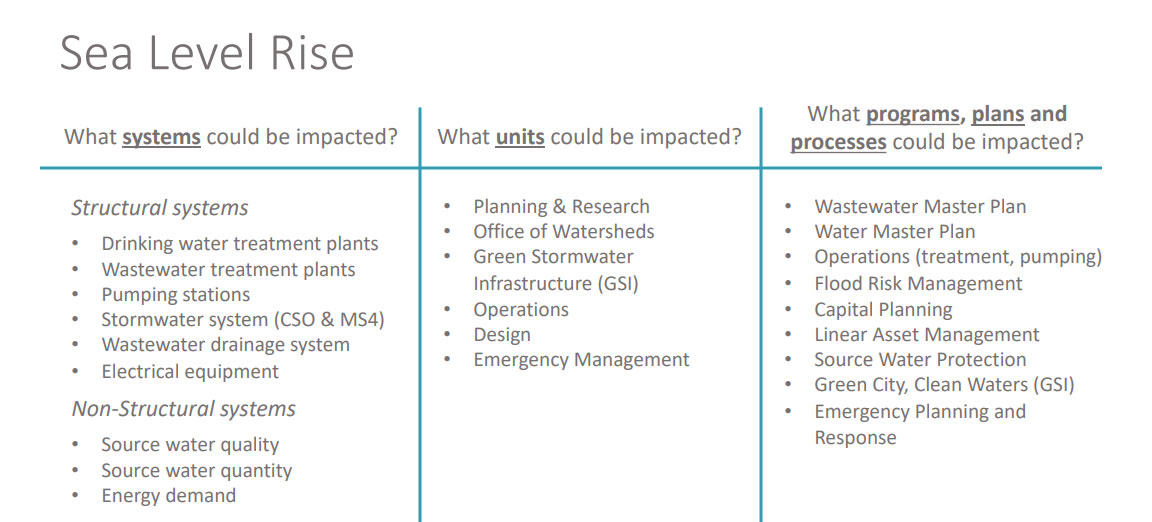
The Climate Change Adaptation Program at the Philadelphia Water Department used the questions above to help develop an internal communications strategy and determine what climate information was needed. By asking which systems, units and programs at PWD could be affected by each climate change impact (the example above is for sea level rise), they were able to identify who their target audiences were and a starting point for developing actionable climate information that could inform existing programs and processes.
SOURCE: Philadelphia Water Department
"It was, and continues to be, important to engage with champions throughout the organization to understand their day-to-day challenges, what regulations or departmental objectives drive their work, and what is valued within their program or unit."
-Julia Rockwell, Climate Change Adaptation Program Manager, Philadelphia Water Department
Example: An external plan
To make sure climate change messages get communicated effectively, the Philadelphia Water Department (PWD) Climate Change Adaptation Program (CCAP) developed both internal (see example above) and external communication plans. This effort is a work in progress, with a goal to get the right messages across in planning meetings and with stakeholder groups. For example, CCAP's external communication strategy document is a resource for staff, particularly PWD public affairs staff, that provides a base from which to develop targeted communication and promote climate change awareness and education. This document is not an action plan, but instead includes strategies, suggested goals and objectives, communication best practices from the literature, available resources from groups like the Yale Program on Climate Change Communication, and audience profiles. These resources have helped improve the utility's collective ability to better engage others.
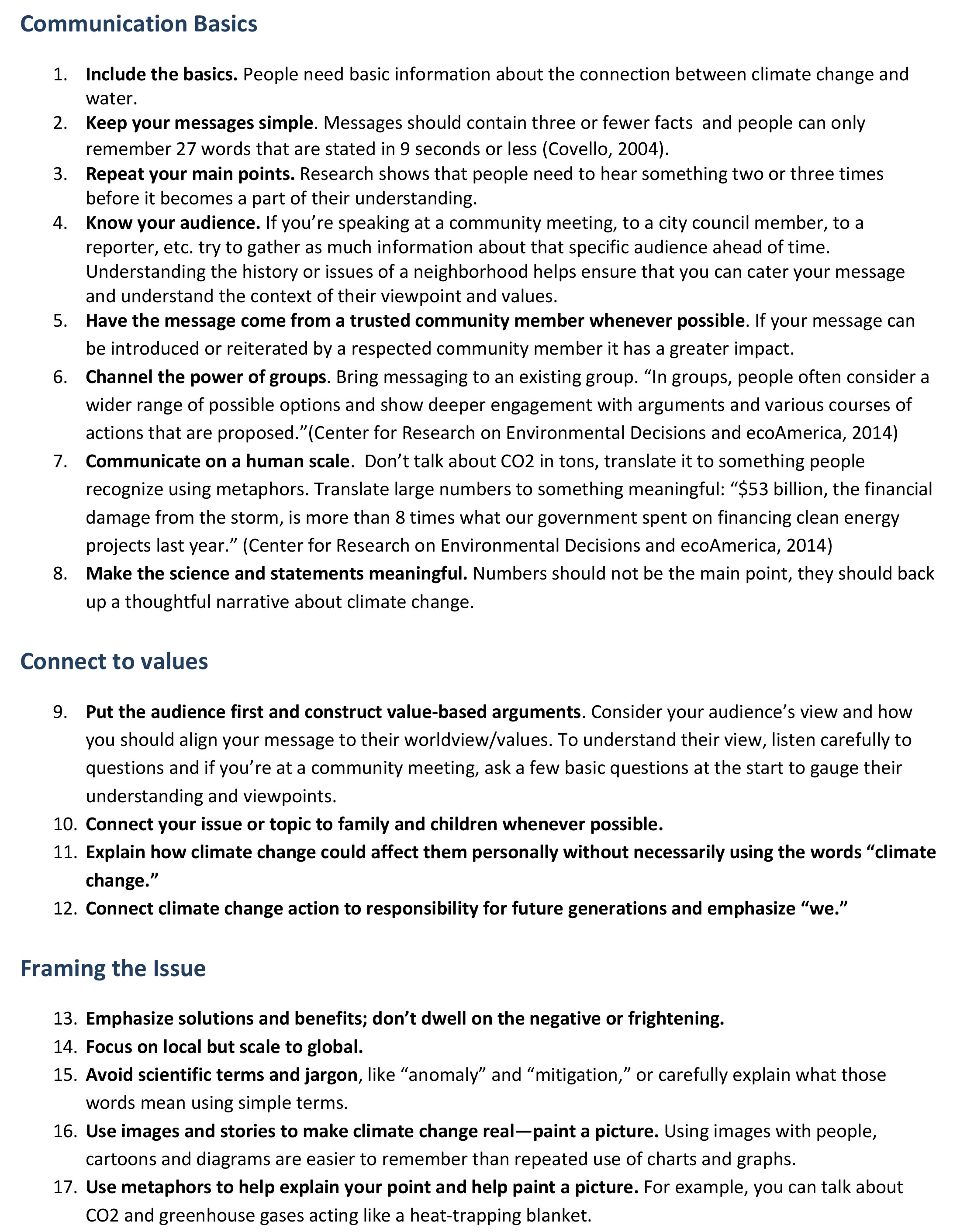
Page from the Philadelphia Water Department's External Communication Strategy. Best Practices are based largely on recommendations from the Center for Research on Environmental Decisions, EcoAmerica, the Water Research Foundation and the Yale Program on Climate Change Communication.
SOURCE: Philadelphia Water Department
Additional details for getting started
Internal Communication
You may not have capacity to develop an internal communications plan, but identifying champions and allies—even if it's just one other staff member—to help amplify your message is a start. Asking questions about each of your climate impacts can also help identify your key audience staff members and determine what climate information they will need.
- What systems could be impacted?
- What units within your utility/organization could be impacted?
- What programs, plans and processes could be impacted?
Remember that the topic of climate change may be overwhelming and often makes existing work more difficult for staff who may already be overworked or have a lot on their plates. When you meet with staff, put yourself in their shoes when thinking about the information you want to convey. Reassure them that you are proactively working together to mitigate climate risk.
External Communication
Public Affairs/marketing teams may also be able to assist with crafting messaging for external audiences. Also, there may be opportunities to provide climate information to your Public Affairs team that can inform existing communication campaigns. For example, explaining how climate change could increase rainfall intensity could be included in a fall leaf cleanup campaign, highlighting the importance of keeping inlets clear to improve drainage system performance.
Information is increasingly available on how to effectively communicate about climate change (see climate communication resources for more details).


Include equity from the beginning
Effective solutions to climate change challenges depend on many factors, all of which might not be clear at the onset. Engaging and focusing on the needs of communities, particularly those most vulnerable to disruptions caused by climate impacts, is best done at the beginning and throughout a project. By improving conditions for the most vulnerable in your community, you also improve conditions for everyone.
Example: Centering community priorities
Sea level rise, urban flooding, and increasingly severe heat island effects disproportionately impact lower income neighborhoods. In Seattle, one neighborhood in particular is comprised of Seattle's lowest-lying lands and faces severe health and environmental injustices, plus increasing pressure of gentrification. Seattle Public Utilities (SPU) is leveraging substantial drainage and wastewater investments in this neighborhood to spur neighborhood capacity building, SLR adaptation planning and multi-benefit projects.
This work is resulting in a Resilience District, framing SLR adaptation as an anti-displacement strategy, driving economic opportunity and affordable housing in concert with water quality and flood mitigation measures. The Resilience District will build on city policies and programs and will also establish a community-led entity so that the community can meaningfully participate in and benefit from public projects. Building strong partnerships with community and philanthropy that can come together to build momentum around each other's investments is essential. So, too, is the community's capacity to order and effectively voice their priorities, since basic needs (affordable housing, anti-displacement measures) may need to be met before they can effectively turn to investing in longer-term climate related adaptation.
SPU is also centering community priorities in its integrated system plan, Shape Our Water, by striving to create a shared vision with Seattle communities and stakeholders. This process will guide SPU's investments in resilient drainage and wastewater systems for the next 50 years. The plan is driven by environmental stewardship, environmental justice, regulatory compliance, affordability, equity, science and data, collaboration and empowerment. The community engagement process is using innovative practices such as public art, fireside chats, and community partners and stories, hear from those who have not previously had a fair opportunity to shape drainage and wastewater decisions.
Example: Strategic planning
The Portland Water Bureau (PWB) embedded equity in every part of its recent five-year strategic planning process, with the goal of creating a plan that reduces systemic inequality and its impacts on employees and the people PWB serves. The utility collected equity-specific risks, scored risk consequences based on equity, identified strategies that would lead to equitable outcomes, and redefined its commitment to equity.
After a couple climate change strategies in the plan were identified as having a larger equity impact, an equity working group within the utility reviewed them and recommended equity-specific actions, which are also documented in the utility's Plan to Advance Equity, Diversity, and Inclusion. For example, because low-income and marginalized communities of color are often most vulnerable to the impacts of climate change, reducing carbon emissions is an important strategy that contributes to racial equity and the PWB's role in mitigating climate change has important equity implications. PWB also has an Equity Manager that leads equity work within the agency and an Equity Committee that advised throughout the strategic plan development process.
Additional resources
Become familiar and stay centered around the US Water Alliance's Pillars of Water Equity framework and what the framework means for your utility's planning and operations.
The Center for Community Investment provides useful resources. While they are not utility-specific, the paper "Community Investments: Focusing on the System" is particularly relevant to utilities.



Make the business case for climate adaptation
Improving resiliency takes time and resources but can also save time and resources. Transparency about financial elements, including tradeoffs in costs and other triple-bottom-line benefits — social, environmental, and financial — can motivate action and demonstrate how adaptation investments can save money in the long run. This helps engage people from the beginning and sustain the effort.
This practice is included under both ENGAGE and SUSTAIN climate adaptation actions. See examples in the SUSTAIN section.

